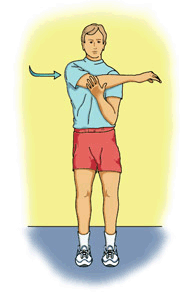Random Friday Thoughts: 2/20/09
Let’s get right to it…
1. Here’s a link to a great news story about Cressey Performance athlete Olympic Bobsled hopeful Bree Schaaf:
Bree Schaff hopes to be on US Olympic Bobsled Team
2. Here’s this week’s mind-numbing personal trainer moment…
Our facility landlord spends much of his winter down in Florida, and as he told me yesterday, he went to a personal trainer down there to help him with some chronic shoulder pain he’s had (this is funny, because I’m in his building and he never thought to ask me, but I won’t digress). I talked with him for a few minutes, and without even having to physically examine him, I could tell it was a classic ol’ supraspinatus tendinosis (external impingement – but it’s more complex than that, as I’ve written in Newslettter 130 and 131). Taking him through some provocative tests just verified everything; he had extremely poor scapular stability (abducted and anteriorly tilted), markedly limited glenohumeral external rotation, and poor thoracic mobility. This is a pretty easy one to fix, I think.
Since he isn’t going to be back up here full-time for a month or two, I asked him what he’d been doing with his personal trainer to address the shoulder issue. So, he shows me this stretch that they’ve been doing three times a week:
For the record, he wasn’t wearing the short shorts and funky tube socks, and didn’t appear so “cartoonish,” but you get the idea. My bigger concern was that this dude was treating a) scapular instability and b) poor external rotation ROM with a stretch into internal rotation without the scapula stabilized. This is analagous to taking someone with poor glute function and stretching the lumbar spine into flexion. You’re stretching the wrong structures at the wrong joint!
And, to take it a step further, this movement actually closely resembles two provocative tests for symptomatic impingement:

The Hawkins Kennedy Test

Yocum's Test
So, I guess you could say that our landlord paying this personal trainer to tell him to do this stretch is roughly on par with paying someone to bang your head against a wall when you have a headache.
Once again, it all comes down to assessment. If you can’t assess, you can’t effectively prescribe exercises to prevent or correct imbalances. For more information, check out Building the Efficient Athlete.
3. I gave Moneyball (one of my favorite books) a mention and some love in a recent newsletter, and then Tony Gentilcore sent me a link about how the book may be turned into a movie starring Brad Pitt. It better be good, because if it isn’t, I’ll berate Pitt mercilessly for tarnishing the reputation of a great read.
That’s all I’ve got for this week, folks. The shoulder rant above sapped the life from me, so I’ll recharge this weekend and bounce back with some good stuff for you on Monday. Enjoy the weekend!




